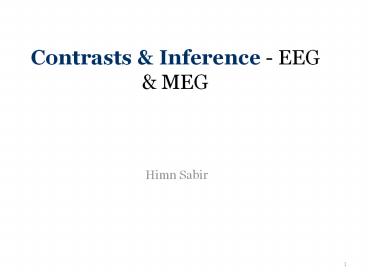Contrasts - PowerPoint PPT Presentation
Title:
Contrasts
Description:
M/EEG modelling and statistics. Epoched time-series data. Data is analysed using the General Linear model at each voxel and Random Field Theory to adjust the p-values ... – PowerPoint PPT presentation
Number of Views:77
Avg rating:3.0/5.0
Title: Contrasts
1
Contrasts Inference - EEG MEG
- Himn Sabir
2
Topics
- 1st level analysis
- 2nd level analysis
- Space-Time SPMs
- Time-frequency analysis
- Conclusion
3
Voxel Space
(revisited)
2/3D images over peri-stimulus time bins
2D scalp projection (interpolation in sensor
space)
3D source reconstruction (brain space)
Data ready to be analysed
4
M/EEG modelling and statistics
Epoched time-series data
Data is analysed using the General Linear model
at each voxel and Random Field Theory to adjust
the p-values for multiple comparisons.
Model specification
Parameter estimation
Time
Time
Hypothesis
Statistic
Single voxel time series
Intensity
Typically one wants to analyse multiple subjects
data acquired under multiple conditions
2-Level Model
SPM
5
1st Level Analysis
Epoched time-series data
- Similar to fMRI analysis. The aim of the 1st
level is to compute contrast images that provide
the input to the second level. - Difference here we are not modelling the data at
1st level, but simply forming weighted sums of
data over time
At the 1st level, we select periods or time
points in peri-stimulous time that we would like
to analyse. Choice made a priori.
Time is treated as an experimental factor and we
form weighted-sums over peri-stimulus time to
provide input to the 2nd level
Example if we were interested in the N170
component, one could average the data between 150
and 190 milliseconds.
1
0
6
1st Level Analysis
Epoched time-series data
Example EEG data / 8 subjects / 2 conditions
For each subject
- Choose Specify 1st-level
- Select 2D images
- Specify M/EEG matfile
- Specify Time Interval
Timing information
5. Click Compute
SPM output 2 contrast images
average_con_0001.img
7
2nd Level Analysis
Epoched time-series data
Given the contrast images from the 1st level
(weighted sums), we can now test for differences
between conditions or between subjects.
2nd level model used in fMRI
2nd level contrast
-1 1
SPM output Voxel map, where each voxel contains
one statistical value
The associated p-value is adjusted for multiple
comparisons
second level
8
2nd Level Analysis
Epoched time-series data
Example EEG data / 8 subjects / 2 conditions
1. Specify 2nd-level
SPM output Design Matrix
2. Specify Design
9
2nd Level Analysis
Epoched time-series data
Example EEG data / 8 subjects / 2 conditions
Ignore brain outline
3. Click Estimate
Output
4. Click Results
5. Define Contrasts
Regions within the 2D map in which the
difference between the two conditions is
significant
10
Space-Time SPMs (Sensor Maps over Time)
Time as another dimension of a Random Field
We can treat time as another dimension and
construct 3D images (2D space 1D peri-stimulus
time)
We can test for activations in space and time
Both approaches available choice depends on the
data
- Advantages
- If we had no a priori knowledge where and when
the difference between two conditions would
emerge - Especially useful for time-frequency power
analysis
- Disadvantages
- not possible to make inferences about the
temporal extent of evoked responses
11
Space-Time SPMs (Sensor Maps over Time)
How this is done in SMP8
Example EEG data / 1 subject / 2 conditions (344
trials)
- Statistical Analysis
- Choose 2D-to-3D image on the SPM8 menu and
epoched data e_eeg.mat
(test across trials)
2. Choose options
32x32x161 images for each trial / condition
4. Estimate Results
5. Create contrasts
12
Space-Time SPMs (Sensor Maps over Time)
How this is done in SMP8
Example EEG data / 1 subject / 2 conditions (344
trials)
Ignore brain outline!!!
Overlay with EEG image
- More than 1 subject
- Same procedure with averaged ERP data for each
subject - Specify contrasts and take them to the 2nd level
analysis
13
Time-Frequency analysis
Transform data into time-frequency domain
Useful for evoked responses and induced responses
Not phase-locked to the stimulus onset not
revealed with classical averaging methods
SPM uses the Morlet Wavelet Transform
Wavelets mathematical functions that can break a
signal into different frequency components.
Tallon-Baudry et. al. 1999
The transform is a convolution
The Power and Phase Angle can be computed from
the wavelet coefficients
14
Time-Frequency analysis
How this is done in SPM8
Example MEG data / 1 subject / 2 conditions (86
trials)
- Choose time-frequency on the SPM8 menu and
epoched data e_meg.mat
2. Choose options
t1_e_eeg.mat and t2_e_eeg.mat
power at each frequency, time and channel (t1)
phase angles (t2)
3. Average
mt1_e_eeg.mat and mt2_e_eeg.mat
4. Display
5. 2D Time-Frequency SPMs
15
Summary
Projection to voxel space
(2D interpolation or 3D source reconstruction)
1st Level Analysis
(create weighted sums of the data over time)
(contrast images input to the 2nd level)
2nd Level Analysis
(test for differences between conditions or
groups) (similar to fMRI analysis)
Time-Space SPMs
(time as a dimension of the measured response
variable)
Time-Frequency Analysis
(induced responses)
16
References
- S. J. Kiebel 10 November 2005. ppt-slides on ERP
analysis at http//www.fil.ion.ucl.ac.uk/spm/cours
e/spm5_tutorials/SPM5Tutorials.htm - S.J. Kiebel and K.J. Friston. Statistical
Parametric Mapping for Event-Related Potentials
I Generic Considerations. NeuroImage,
22(2)492-502, 2004. - S.J. Kiebel and K.J. Friston. Statistical
Parametric Mapping for Event-Related Potentials
II A Hierarchical Temporal Model. NeuroImage,
22(2)503-520, 2004. - Todd, C. Handy (ed.). 2005. Event-Related
Potentials A Methods Handbook. MIT - Luck, S. J. (2005). An Introduction to the
Event-Related Potential Technique. MIT Press.
17
Thank You!
For difficult questionsj.kilner_at_fil.ion.ucl.ac.u
k(James Kilner)











![The Role of Contrast in Metonymy (and Other Figures): (Comparisons and Contrasts) [with some additions after the conference] PowerPoint PPT Presentation](https://s3.amazonaws.com/images.powershow.com/7315021.th0.jpg?_=20151028031)



















